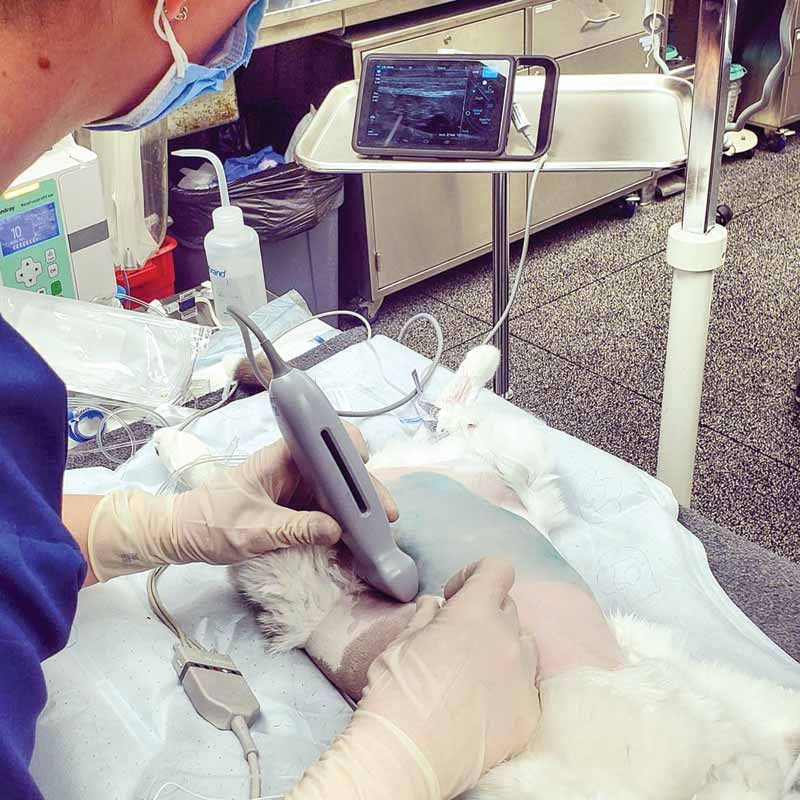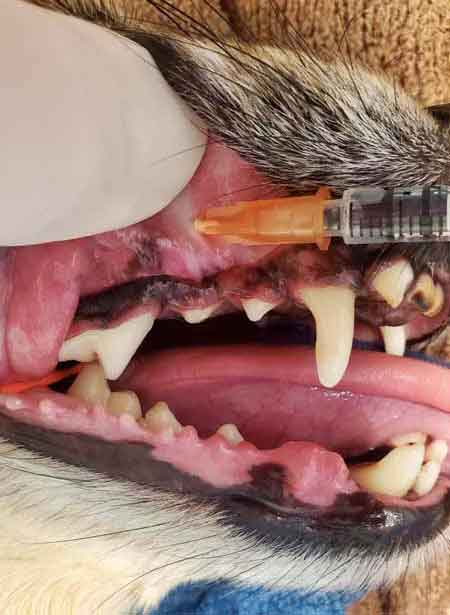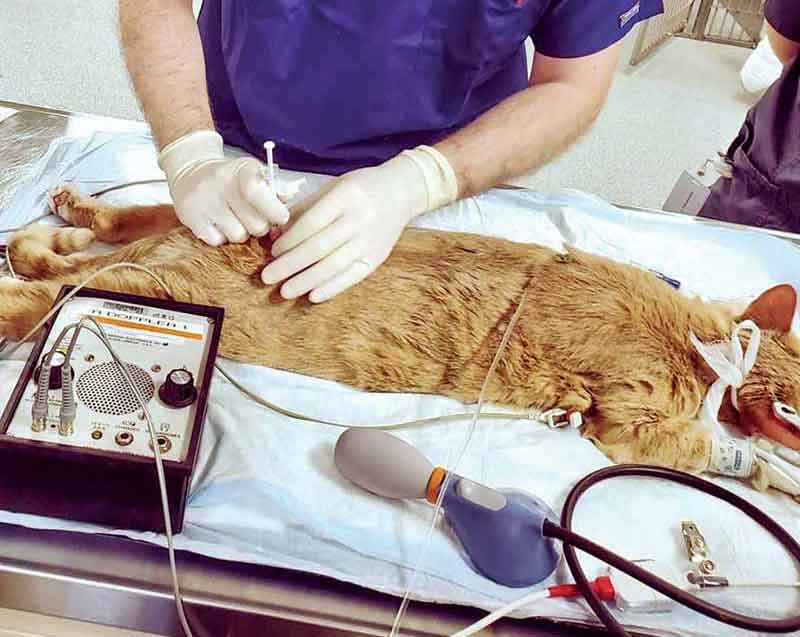
Photos courtesy Tasha McNerney
Analgesia is a critical component of veterinary medicine, and its use is essential to providing high-quality medical care for animals. In addition to making a pre-anesthetic plan, regional anesthesia/analgesia is an important part of balanced anesthesia in veterinary medicine. Regional analgesia involves using local anesthetics to block specific nerve pathways in a specific area of the body.
Regional anesthesia plays an essential role in balanced anesthesia in veterinary medicine. It offers several advantages over general anesthesia, including better pain control, reduced risk of complications, and faster recovery times. Regional anesthesia can be used alone or in combination with general anesthesia, depending on the procedure’s requirements and the animal’s overall health.
In some instances, such as critical patients that may not be able to handle the side effects of inhalant anesthesia, regional anesthesia is one of the only techniques that provide complete blockage of pain signals going to the brain, without the added cardiac depression that can come with inhalant anesthesia. Another advantage of intraoperative antinociception is improved anesthetic safety because the inhalant dose, or minimum alveolar concentration (MAC), required to produce a surgical plane of anesthesia is decreased in patients receiving local/regional blocks as part of a multimodal analgesic protocol.1
In this article, we will go over five common regional anesthesia blocks your clinic can utilize to increase patient comfort, build staff job satisfaction, and build revenue.
1) Transversus abdominus plane (TAP) block. This is a regional anesthesia technique that involves injecting a local anesthetic into the transversus abdominus plane, which is located between the internal oblique and transversus abdominus muscles. TAP block is commonly used to provide analgesia for abdominal surgeries in dogs and cats. The procedure is relatively simple and involves placing the animal in lateral recumbency and identifying the correct injection site. The local anesthetic is injected before the surgery using a flat ultrasound probe to view the layers of the abdominal fascial plane.
With this technique, the local anesthetic will distribute along the fascial plane and meet the peripheral nerves originating in the ventral branches of the relevant spinal nerves.2 While this block will not subdue pain signals arising from the internal organs, it does cover the skin and muscle layers of the abdomen. The TAP block, especially when combined with a long-lasting local anesthetic, can provide a smooth recovery with long-lasting analgesia at the incision site. A 2022 study showed a mixture of bupivacaine and dexmedetomidine administered via TAP block provided superior post-op analgesia compared to a placebo, but the same level of analgesia as liposomal encapsulated bupivacaine.3
2) Epidurals involve injecting a local anesthetic into the epidural space, which is located between the spinal cord and the vertebral column. Epidurals can provide analgesia for surgeries involving the pelvic region, hind limbs, or abdomen. These can be administered as a single injection or as a continuous infusion with an epidural catheter.
There are many options when it comes to the types of drugs placed in the epidural space, from preservative-free local anesthetics to opioids, such as preservative-free morphine. A clinician may choose to use an opioid-only epidural to provide superior analgesia while maintaining motor function. It is important to note all drugs entering the epidural space should be preservative-free.

The use of epidurals is common in many surgeries, such as cesarean sections. For many practices that perform emergency C-sections, having someone on staff trained and proficient in epidurals can provide greater overall patient safety as a less inhalant anesthetic (which can cause vasodilation and decreased cardiac output) is used.
Epidurals do require a certain level of skill and training, however, there are many options for hands-on training available with wet labs being offered at many major conferences.
3) Sacrococcygeal blocks. One of the most underutilized of the regional analgesia techniques, sacrococcygeal blocks can be a literal lifesaver for critical urethral obstruction patients that require analgesia but are too critical for anesthetics or sedatives that may cause hypotension, bradycardia, or arrhythmias. Sacrococcygeal blocks involve injecting a local anesthetic into the nerves that supply the tail region. The procedure is commonly used to provide analgesia for urethral obstructions, but can be useful for tail amputations, anal sacculectomy, and perineal urethrostomy patients as well. The procedure involves identifying the space where the end of the sacrum meets the first coccygeal vertebrae and administering the local anesthetic. One sign the block is being effective is a complete loss of anal tone and the penis will relax enough to come out of the prepuce, helping to facilitate urinary catheterization. Sacrococcygeal blocks can be advantageous compared to epidurals as motor function is still preserved in the hind end and the animal can easily ambulate.
4) Dental blocks. These are not only one of the best ways to provide analgesia to patients experiencing dental extractions, but are also a safer, more cost-effective analgesia technique than higher concentrations of inhalant anesthesia. Often, dentistry patients are older, with multiple concurrent disease states that negate the use of certain drugs, such as alpha two adrenergic agonists (e.g. dexmedetomidine), which can cause bradycardia; or phenothiazine tranquilizers (e.g. acepromazine), which can contribute to hypotension. It is important to remember inflamed gingival tissue can have a higher pH, which can affect the onset of action in local anesthetics. Some will buffer the local anesthetics with sodium bicarbonate to help with any nociceptive reaction to the low pH.
However, a meta-analysis in human dentistry patients showed no benefit. Adjusting the pH of lidocaine was not effective in reducing the pain of intraoral injections in normal or inflamed tissues. The onset of anesthesia was not improved using buffered lidocaine in normal tissues.4 As always, knowledge of anatomy and training on foramen/nerve location is imperative when performing dental blocks, including, but not limited to, infraorbital block, maxillary block, mental block, and inferior alveolar block.
5) Local infiltration anesthesia. This involves injecting local anesthetic directly into the surgical site to provide analgesia. The procedure is commonly used to provide analgesia for minor procedures, such as wound closures or biopsies. Local infiltration anesthesia is relatively simple and involves identifying the injection site and administering the local anesthetic. Depending on the timing and level of pain, you may decide to utilize a short-acting local anesthetic such as lidocaine, or a longer-lasting option such as bupivacaine. Adding analgesics such as buprenorphine or dexmedetomidine can also increase the duration of action, sometimes up to 24 hours.5
Regional anesthesia is an important part of balanced anesthesia in veterinary medicine. It offers several advantages over general anesthesia, including better pain control, reduced risk of complications, and faster recovery times. Regional anesthesia can be used alone or in combination with sedative drugs, other systemic analgesics, or general anesthesia. Not only is it an advantageous practice for the comfort of your patients, but also cost saving. For every surgical or dental patient, a regional anesthesia technique can be incorporated in the same way a pre-med or induction agent would. Clients also enjoy knowing their pet receives the same level of analgesia care they would get for a similar procedure.

Tasha McNerney BS, CVT, CVPP, VTS (Anesthesia), is a certified veterinary technician and veterinary pain practitioner from Glenside, Pa. McNerney works closely with the IVAPM to educate the public about animal pain awareness. She loves to lecture on various anesthesia and pain management topics around the globe and was previously named a VMX speaker of the Year for veterinary technicians. McNerney has authored numerous articles on anesthesia and analgesia topics for veterinary professionals and pet parents. In her spare time, she enjoys reading, spending time with her husband and son, and recording the Veterinary Anesthesia Nerds podcast.
References
- Aguiar, J., Chebroux, A., Martinez‐Taboada, F., & Leece, E. A. (2015). Analgesic effects of maxillary and inferior alveolar nerve blocks in cats undergoing dental extractions. Journal of Feline Medicine & Surgery, 17(2), 110–116. https://pubmed.ncbi.nlm.nih.gov/24820999
- Bhatia N, Sen IM, Mandal B, Batra A. (2019) Postoperative analgesic efficacy of ultrasound-guided ilioinguinal-iliohypogastric nerve block compared with medial transverse abdominis plane block in inguinal hernia repair: a prospective, randomized trial. Anaesth Crit Care Pain Med.;38(1):41–45. https://pubmed.ncbi.nlm.nih.gov/29605459/
- Campoy, L., Martin-Flores, M., Boesch, J. M., Moyal, M. N., Gleed, R. D., Radhakrishman, S., Pavlinac, R. M., Sieger, J. L., Colon, C. S., & Magidenko, S. R. (2022). Transverse abdominis plane injection of bupivacaine with dexmedetomidine or a bupivacaine liposomal suspension yielded lower pain scores and requirement for rescue analgesia in a controlled, randomized trial in dogs undergoing elective ovariohysterectomy, American Journal of Veterinary Research, 83(9), ajvr.22.03.0037. Retrieved May 24, 2023, from https://doi.org/10.2460/ajvr.22.03.0037
- Aulestia-Viera, PV, Braga, MM, Borsatti, MA. (2018) The effect of adjusting the pH of local anesthetics in dentistry: a systematic review and meta-analysis. International Endodontic Journal, 51, 862– 876. https://pubmed.ncbi.nlm.nih.gov/29377171/
- Bartel, A. K., Campoy, L., Martin‐Flores, M., Gleed, R. D., Walker, K. J., Scanapico, C. E., & Reichard, A. B. (2016). Comparison of bupivacaine and dexmedetomidine femoral and sciatic nerve blocks with bupivacaine and buprenorphine epidural injection for stifle arthroplasty in dogs. Veterinary Anaesthesia and Analgesia, 43(4). https://pubmed.ncbi.nlm.nih.gov/26529670
